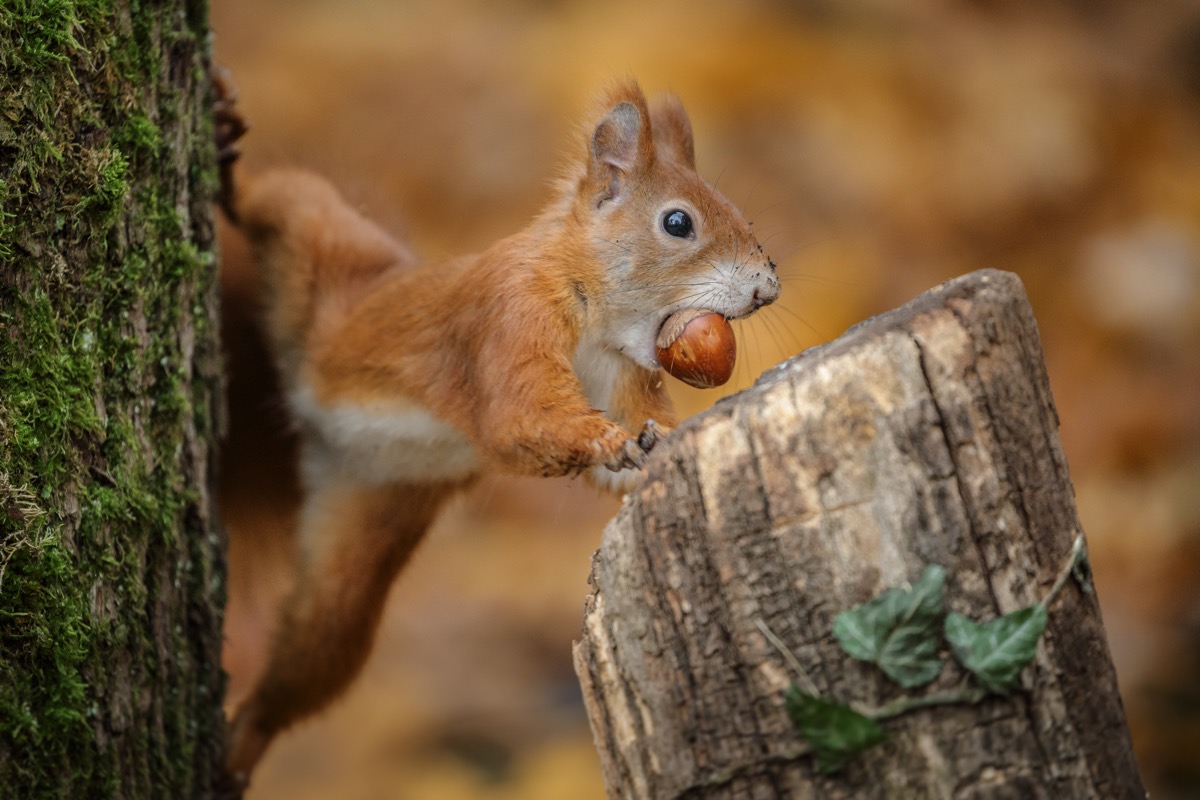
How Do Squirrels Remember Where They Buried Their Nuts?

Few things symbolize the onset of fall quite so well as the sight of a squirrel scampering around a park, industriously burying nuts. As the weather cools and the leaves turn, squirrels engage in this frantic behavior to prepare for the upcoming shortages of wintertime.
But have you ever wondered how effective the squirrel's outdoor pantry project could really be? After going to all that effort to conceal its winter stash, how does the squirrel actually find the buried treasure again, when it's needed most?
First, let's backtrack slightly, because the way that squirrels bury their food yields some interesting clues. Animals that store food to survive the winter don't just do so randomly: They typically use one of two strategies. Either they larder-hoard — meaning they store all their food in one place — or they scatter-hoard — meaning they split up their bounty and stash it in many different locations. [The 12 Biggest 'Little' Mysteries of Fall — Solved!]
Most squirrel species are scatter-hoarders — hence the characteristic dashing they do between different piles of buried food. "This style of food storing probably evolved because it reduces the risk of suffering a major loss," said Mikel Maria Delgado, a postdoctoral fellow at the School of Veterinary Medicine at the University of California, Davis, who has studied squirrel behavior for severalyears. In other words, the more widely dispersed the food, the lower the risk that a hungry competitor will discover the squirrel's entire supply and destroy it in one go.
In recent research published in the journal Royal Society Open Science, Delgado showed that squirrels will arrange and bury their stash according to certain traits, such as the type of nut. This is known as "chunking," and research shows that in other species, such behavior allows animals to mentally organize their hoard, which may help them remember where it is later on.
That banishes any idea that squirrels are haphazardly chucking bits of food down holes in the ground, and simply hoping to stumble across it later. "I think the body of research about how squirrels handle and bury food clearly demonstrates that their behavior is not random," Delgado told Live Science. On the contrary, there appears to be a meticulous strategy behind the way they store food.
How does that translate into how they find their artfully concealed stash? Depending on the squirrel species and the type of nut, squirrels are generally able to retrieve up to 95percentof their buried food, research shows. So there's clearly more than chance behind this process.
Sign up for the Live Science daily newsletter now
Get the world’s most fascinating discoveries delivered straight to your inbox.
It was long believed that squirrels simply relied on their sense of smell to find their food. But while smell definitely comes into it, a growing body of research suggests that memory plays a much more crucial role.
A seminal 1991 research paper published in the journal Animal Behavior showed that even when multiple grey squirrels (Sciurus carolinensis) bury their stash in close proximity to one another, individuals of this species will remember and return to the precise locations of their personal cache. This is echoed by multiple other studies, showing that the squirrels' spatial memory helps them map out the territory around them to find their food. Under certain conditions — like when their nuts are buried under snow — a sense of smell won’t alwaysbe effective in helping them find food. So, it makes sense that squirrels couldbe relying on other cues. [Why Do Squirrels Chase Each Other?]
"While scatter-hoarding squirrels probably also use their sense of smell to locate caches, they do remember their caches. We don't know the exact mechanisms, but it probably includes spatial cues in the environment," Delgado told Live Science.
Pizza Ka Yee Chow, a postdoctoral research fellow at Hokkaido University in Japan, who studies squirrel cognition, agrees. "From my own observation, I think they are using landmarks. They recognize the trees, and they are gauging the distance between themselves, the tree and their own nests," she said.
The organizational chunking behavior, which Delgado identified for the first time in squirrels, may also function to provide memorable cues about the food they're burying. This tactic could "decrease memory load," helping squirrels recall where they put it, Delgado wrote in the Royal Society Open Science study. "No one has directly tested what the potential benefits of chunking would be for squirrels, but we anticipate it might aid in future retrieval of caches," she said.
Researchers have observed that when squirrels scatter-hoard in confined areas, they also seem to be able to remember the location of their caches in relation to one another, suggesting that they build a detailed mental map of where their food lies.
Other studies on squirrel behavior have added weight to the idea that memory underlies squirrels' nut-retrieving skills. In Chow's study on squirrels, published in 2017 in the journal Animal Cognition, she showed that impressive memory spans enable squirrels to successfully recall the solution to a difficult task (manipulating levers to open a hatch that releases a prized hazelnut) more than two years after they first learned it. "They always a find a way to do what they want to do," Chow told Live Science. "They are so dedicated!" This also points to long-term memory as part of the reason squirrels can so specifically recall the location of their nutty bounty.
Over the decades, a plethora of studies have revealed that there's more to squirrels than meets the eye. For instance, researchers think squirrels may even be doing quality control on their bounty. The animals have been observed pawing over nuts and seeds for long periods of time before they bury their stash — something that might help them select nuts with the highest nutritional content, and those least likely to perish underground.
Squirrels will often also meticulously rearrange leaves over disturbed soil to hide their burial sites. Commonly, they also pretend to bury nuts when other squirrels are watching — and then scurry off to a secret location where they actually hide their edible treasures.
In essence, squirrels may covertly hide their nuts, but there's nothing nutty about this behavior. Said Chow, "We think these little creatures may be way smarter than we thought."
Originally published on Live Science.

Emma Bryce is a London-based freelance journalist who writes primarily about the environment, conservation and climate change. She has written for The Guardian, Wired Magazine, TED Ed, Anthropocene, China Dialogue, and Yale e360 among others, and has masters degree in science, health, and environmental reporting from New York University. Emma has been awarded reporting grants from the European Journalism Centre, and in 2016 received an International Reporting Project fellowship to attend the COP22 climate conference in Morocco.









